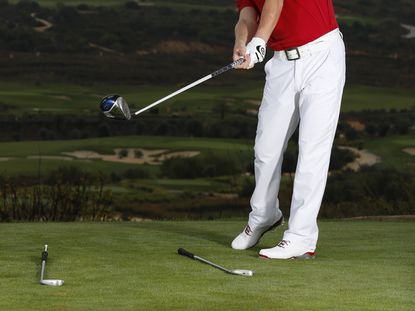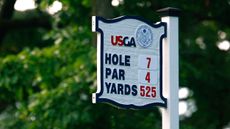Clear Your Hips For Power Drives
PGA pro Andrew Jones explains how to clear your hips for power drives and offers four more tips for bigger hits


Some players struggle to create power as they get stuck through impact. Here, Golf Monthly Top 50 Coach Andrew Jones explains how to clear your hips for power drives and offers four more tips for bigger hits.
To create speed at impact your body must able to rotate powerfully through the hitting zone and so its imperative that you clear your hips for power drives. For some golfers, the left hip gets in the way through impact and the player gets stuck – often leaking shots to the right. You need to be able to swing through to a full and balanced finish. If you struggle with clearing your left hip through impact, take your normal address position and then move your left foot back a fraction. Importantly, as you do this keep your shoulders square to your ball-to-target line. This simple adjustment will help your body rotate to ensure you complete the swing and create as much power as possible.
Takeaway & turn
To hit the ball further you need to set some important fundamentals at the start that will help you build speed through the swing. Obviously, this begins with an athletic address position and a stance that’s slightly wider that usual. Henrik Stenson is a great player to copy to set a strong address position. From there make a smooth, wide takeaway. The width here is crucial as it will help initiate your weight movement and create clubhead speed. Rotate your upper body to reach the top of the backswing so that your left shoulder is behind the ball at the top. A good upper body coil combined with your weight moving onto your right foot are two of the important building blocks you need to hit long drives.
Starting down
The transition from backswing to downswing is crucial to get right. If you can secure the correct sequence of moves from the top you’ll create speed without trying and also get the club working on a great path. From the top, you want your hips to move a little towards the target. This is the trigger for the downswing that will allow your hands to drop into the ideal position on the way down. This will help you create lag – the most important ingredient to effortless power. A great player to watch for this is Freddie Couples. He achieves this sequence with ease and having a picture in your mind of the way he starts his downswing is always worthwhile.
Speed at impact
Get the Golf Monthly Newsletter
Subscribe to the Golf Monthly newsletter to stay up to date with all the latest tour news, equipment news, reviews, head-to-heads and buyer’s guides from our team of experienced experts.
If you get some of these basics right, you’ll start to create more speed where it matters most: impact. However, your swing as a whole needs a freedom and fluidity that helps you build speed towards impact. Firstly, ensure that you aren’t gripping the club too tight at address. Strangling the club will only tighten the muscles in your forearms and prevent you from creating your optimum power. Now flip the club round so that you are holding the shaft at the head end. Make a few swings and listen for the swoosh. If the sequence of your swing is right, the swoosh will come through impact – not before, or after!
Weight movement
One of the most common killers of both power and accuracy is moving your weight in the wrong direction during the swing. Falling onto your back foot through impact will cause you to hit weak slices (and fat or thin strikes with your irons). A great drill is to hit some shots with a mid-iron off a downhill lie. As you reach the top of the backswing, the slope will encourage you to move your weight towards the target on the way down. You can then use that weight shift to help you hit longer shots.

Location: Walmer & Kingsdown Golf Club
After turning professional in 1991, Andrew served as Assistant Pro at Royal Cinque Ports from 1993 until 1998, before spending three years as Head Pro at Lydd Golf Club. He remains in Kent and, after a spell as the Director of Coaching at Sene Valley, is now the Club Professional at Walmer & Kingsdown Golf Club.
Students learn best when...
They have bought into your vision, passion and enthusiasm as a coach and are prepared to go on the journey with you sharing experiences and opinions with an open mind to what is necessary to improve their game. Both the pupil and the coach need to be entering this relationship with eyes, ears and senses wide open and a willingness give it a go!
Greatest teaching influence:
Fellow Top 50 coach, former boss and mentor, Andrew Reynolds. In my early years as a trainee PGA assistant at Royal Cinque Ports, he instilled in me the importance of the analysis of ball flight and also identifying cause and effect within the swing. Other notable (Tour) coaches I have studied carefully during my development have been David Leadbetter and Butch Harmon.
Most common problem:
The grip. For me, it has to be the poor connection to the club itself that can have a fundamental and sometimes catastrophic influence on how we stand to, move and deliver the club to the ball.
-
 The Secret Result Of A Unique PGA Tour Qualifying Event (Involving Eight YouTubers) Set To Be Revealed
The Secret Result Of A Unique PGA Tour Qualifying Event (Involving Eight YouTubers) Set To Be RevealedGolf content creators such as Grant Horvat and Dan Rapaport went up against eight professionals for one spot at the PGA Tour's upcoming Myrtle Beach Classic
By Jonny Leighfield Published
-
 Do Par 4s Have To Be A Minimum Or Maximum Length?
Do Par 4s Have To Be A Minimum Or Maximum Length?Can a par 4 be 200 yards or 550 yards if so desired? Are there actually any rules that say how long or short 'two-shotters' have to be?
By Roderick Easdale Published